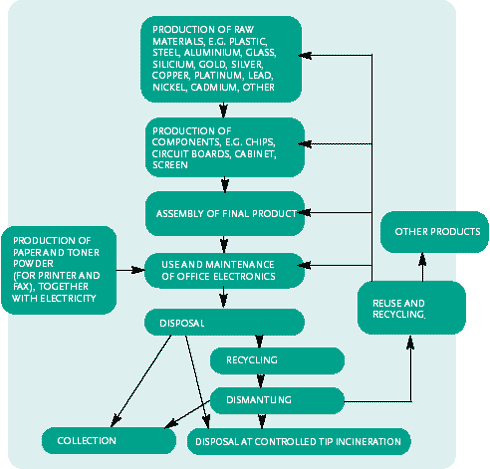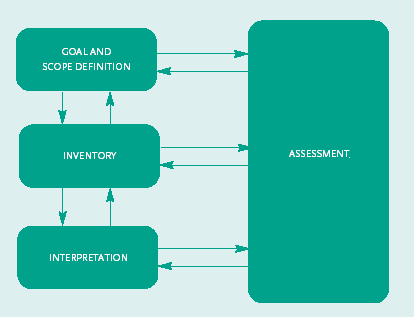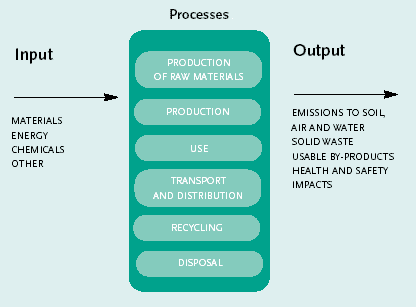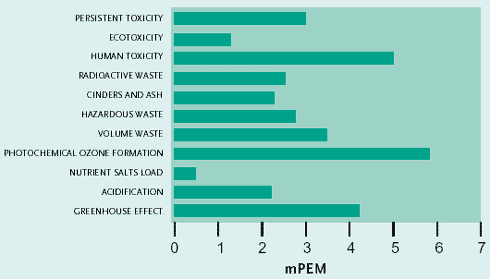Manual on Product-Oriented Environmental Work
Annex 1. Introduction to life cycle assessments
The purpose of this annex is to give a brief introduction to life cycle assessments and to what they can be used for. At the end of the tool, Danish companies' experiences with the use of life cycle assessments are described.
1.1 What is an LCA?
A life cycle assessment is an inventory and assessment of the environmental impacts that occur during a product's life cycle, including resource consumption and emissions/discharges.
A product's life cycle comprises the phases through which a product passes, from extraction of raw materials, through production and use, to final disposal of the product. The diagram in figure 1 shows the life cycle for office electronics.
1.1.1 The goal in connection with product-oriented environmental work
In connection with product-oriented environmental work, the purpose of carrying out a life cycle assessment is to make an inventory of and assess the total environmental impacts during a product's life cycle and thus gain a possibility of reducing them.
By taking account of all the environmental impacts in a product's life cycle, one avoids suboptimisation, i.e. modifications resulting in environmental improvements in one phase of the product's life, e.g. production, leading to increased environmental impacts in another phase of the life cycle, e.g. disposal, and the environmental work can be addressed to those phases in the product's life cycle in which the greatest environmental improvements can be achieved.

Figure 1:
Diagram showing the life cycle of office electronics, from "Background
Documentation for Office Electronics", Danish EnvironmentalProtection Agency, 1998
1.1.2 Use
Today, life cycle assessments of products1 are used by different players and for different purposes. Examples are:
| political decisions | |
| criteria for ecolabels | |
| basis for recommendation in Green Buying Guides for purchasers | |
| support for decisions and prioritisation in companies | |
| product development in companies. |
The authorities have used life cycle assessments as the basis for national action plans. For example, the political decision to recycle paper instead of incinerating it is based on a life cycle assessment of the two disposal systems. Recently, the Danish EPA used a life cycle assessment of the Danish bottle return system as opposed to introducing cans to argue that Denmark should keep the present bottle return system.
That life cycle assessments cannot yet be based on exact methods and that methods and interpretation of results are still open to discussion can be seen, for instance, from the debate that followed the lastmentioned life cycle assessment of beverage packaging2. It is therefore necessary to pay great attention to what life cycle assessments can be used for and how they are used.
Life cycle assessments provide the background knowledge behind the preparation of the criteria that a product must meet in order to be granted one of the official eco-labels (the Nordic Swan or the EU's Flower). Tool 2 in Part B concerns ecolabels.
The Danish EPA has issued a number of Green Buying Guides for public purchasers. The guides provide advice to purchasers on environmentally sound purchasing. The guides are also based on life cycle assessments. Tool 3 in Part B concerns Green Buying Guides.
Many Danish companies also use life cycle assessments or elements of them. The LCA work is used in product development in some companies, as an aid to the development of products with reduced environmental impacts. It is also used to establish environmental knowledge.The knowledge you gain from carrying out life cycle assessments for one or more of your company's products can also be used as environmental documentation for customers and other stakeholders - in the form, for example, of an environmental product declaration. Tool 4 in Part B concerns environmental product declarations. The knowledge built up can also be used to identify action areas for the company's environmental work.
1.1.3 Limitations
There are some limitations connected with the preparation and use of life cycle assessments as a method.
As a method, LCA is at an early stage of development. There is therefore still a great need for development and experience with the use of existing methods.
Another important limitation is the fact that choices and assumptions are often based on subjective evaluations, so it can be difficult and, in many cases, directly impossible to compare the results of different LCA´s.
A third important limitation is that the available data are in many cases encumbered with great and varying uncertainties that make it difficult to interpret the results.
Lastly, it is often very difficult to collect data for the life cycle phases that lie outside your own company because most companies have not yet calculated the individual products' environmental impacts and are therefore unable to provide this information.
However, despite these limitations and barriers to the work, a life cycle assessment can provide valuable information for use in prioritising environmental work.
1.2 Standardisation of the work
In the last few years, a number of standards have been prepared for life cycle assessments. Internationally, the standardisation work is taking place under ISO.
The standardisation of the life cycle work is divided into four standards (ISO 14040-14043). Standards ISO 14040 and ISO 14041 are approved standards. ISO 14042 and 14043 have not yet been published officially, but there are English drafts of them with the formally adopted content.
Unlike the situation with ISO 14001 (with requirements concerning environmental management systems), it is not possible to be certified in accordance with the ISO standards. However, it is recommended that companies have a critical review carried out by an independent expert or by a group of stakeholders headed by an expert. This critical review is intended to facilitate understanding of the LCA and increase its credibility3.
1.2.1 ISO 14040
The ISO 14040 standard covers 'Principles and framework', i.e. the general principles and structure of the work. The standard describes the basic phases and elements of a life cycle assessment and the uses and limitations of the method. The phases are shown in figure 2.
As will be seen, LCA is an iterative process in which it is often necessary to go back and change the goal and scope definition on the basis of experience and interpretations on the way - for reasons of data accessibility, for example, or a need to change the focus as a consequence of growing environmental understanding.

Figure 2:
Phases in a life cycle assessment (ISO 14040, 1997)
1.2.2 ISO 14041
The ISO 14041 standard deals with 'Goal and scope definition and inventory analysis'.
The ISO 14042 standard deals with 'Life Cycle Impact Assessment, LCIA'.
The ISO 14043 standard deals with 'Life Cycle Interpretation'. It provides a framework for systematic interpretation of the data collected.
The ISO standards describe the general framework for an LCA but do not offer any method for performing one and give only a few examples of how to perform an LCA in accordance with the standards. A technical report, with examples of data collection (life cycle inventory, LCI) in accordance with ISO 14041 are in course of preparation.
1.3 The phases in LCA
The assessment phase, see figure 2, is probably the phase that is most discussed in connection with LCA method development and in connection with the standardisation work in ISO. It is thus not surprising that it has been difficult to adopt a standard in this area and that the standard now adopted does not indicate which method is to be used in the assessment.
The various phases in an LCA (see figure 2) are briefly discussed below.
1.3.1 Goal and scope definition
It is extremely important to make a thorough description of the goal (who the target group is and what the result is to be used for), and a thorough definition of the scope of the work before this is initiated. It is essential, for example, to clarify and describe how the product's life cycle is defined (it is not normally possible to go into every detail), how the data is to be collected, what assessment method is to be used (including the parameters that are to be assessed, including whether occupational health is to be included), and how the result is ultimately to undergo a 'critical review'/be quality assured. A very important part of this phase is to establish the product's functional unit, which describes the function fulfilled by a product. This is necessary as a basis for comparison. For example, when considering milk supply, it is no good comparing one kilo of glass with one kilo of cardboard or plastic. Here, a suitable functional unit would be supplying one litre of milk at a given temperature.
Another important part of the preliminary work is to make a process tree or a flow diagram showing inputs and outputs from the various processes. Figure 3 shows a simplified diagram of the inputs and outputs that are to be mapped in a life cycle assessment.

Figure 3:
Diagram showing inputs, outputs and processes in a product’s life cycle
1.3.2 Inventory
The inventory, which is created by reviewing the data associated with the product's life cycle, is the most time-consuming phase in an LCA. Experience shows that it is often difficult to obtain data on resource consumption and emissions from subsuppliers or information about how the product is used and disposed of. In addition, understanding is often gained on the way that makes it necessary to change the data collection strategy. For example, it may be found that some data are difficult to obtain or that some processes have a much greater environmental impact than others.
One way of reducing the time consumption is to use existing data from databases or earlier LCAs. It is important to note that the quality of these varies greatly. It is also important to note that there may be big differences between data for the same process, depending on several factors, including the technology used, the geographical siting and the delimitation of the parameters that are included. Some data will be specific for a specific process in a specific locality, while others will be average data for, for example, an industry. It is therefore necessary always to take a critical view of collected data.
1.3.3 Assessment
As described, the assessment phase is the most debated phase in an LCA. In the Danish LCA method, EDIP (Environmental Design of Industrial Products), resources, emissions and occupational health are assessed. A general presentation of the method is given below. For a more detailed description of EDIP, see the reference list.
Resources are fossil fuels, metals, other minerals, biomass, water and the category "other", which covers all the resources that cannot be categorised in the other categories. Resources are assessed by comparing the consumption per functional unit with the annual consumption of the given resource and with known reserves.
Emissions are assessed in relation to their potential to contribute to the following environmental impacts: greenhouse effect, ozone depletion, photochemical ozone formation, acidification, nutrient salts load, persistent toxicity, ecotoxicity, toxicity for humans, and a number of waste parameters. The calculated environmental potentials are then compared with the total environmental load within the described categories and a weighting based on the political reduction targets for the environmental impacts described.
The occupational health assessment includes an assessment of the potential for:
| chemical impacts to lead to cancer, reproductive damage, allergy and damage to the nervous system | |
| monotonous, repetitive work to lead to musculoskeletal damage | |
| noise to lead to hearing damage | |
| accidents to lead to bodily harm. |
EDIP, including the PC tool, includes parameters for assessing a wide range of the most common resources and emissions on the basis of the above-mentioned principles. However, there will often be a number of different resources and emissions for which assessment parameters have not been established. Expert assistance is normally needed for assessment of a 'new' resource or emission on the basis of the method's rules. However, in many cases, one can make a preliminary assessment/sensitivity assessment by assuming a 'worst case scenario' to see whether the given resource or emission can be presumed to affect the final result.
1.3.4 Interpretation
In this phase, the results from the other phases are summed up, discussed and interpreted in relation to the stated goal. On the way, these considerations may give rise to changes in the definition and inventory. The interpretation phase must also deliver the final output to the parties that are going to use the results of the LCA. Lastly, the interpretation includes uncertainty and sensitivity assessments of the results achieved and a critical review carried out by internal or external parties.
1.4 PC tools
Many practitioners like to use a PC tool in connection with the work with LCA.That facilitates the calculations and helps to 'keep tabs' on the large quantity of data and makes the work more systematic.
The various PC tools differ greatly. Besides the purely technical aspects of using them, one must be aware that the assessment part is different and that the data accompanying the PC tools are of varying quality.
1.4.1 The Danish EPA's LCV tool
One of the most widely used PC tools in Denmark is the Danish EPA's LCV tool, which has been based on and developed in connection with the EDIP project. The tool consists of two parts - a calculation part and a database. The calculation part follows the EDIP method very closely. The use of the tools is described in a special publication and the method is described in a number of books.
The database contains mainly data from five examples of industrial products worked with under the EDIP project. The Danish EPA has initiated a project to update the database in 2000.[Der burde måske være en note enten her eller i begyndelsen af håndbogen om at: "The manual was written and published in 2000 and therefore relates to the situation at that time". It is naturally also possible to insert one's own data.
For emissions, the assessment (see method description in 1.3) results in an environmental profile as shown in figure 4.
It must be stressed that, in its present form, the tool is available as a beta version, which has certain deficiencies. For example, one has to have a thorough knowledge of the tool in order to use it correctly. The Danish EPA is at present considering the future fate of the tool.
1.4.2 Other tools
Another tool used to some extent in Denmark is Simapro, which is a Dutch PC tool. It is preferred by some companies because it contains a large database and has a better user interface than the LCV tool. On the other hand, the assessment part is not based on the EDIP principles but on a Dutch method. However, EDIP's assessment method can be inserted into Simapro.

Figure 4:
Example of weighted environmental profile for emissions during a
product’s life cycle. The unit tMPE (target Milli-Person Equivalent) refers to the
EDIP method’s weighting with political reduction targets.
There are a number of other PC tools on the market that are suitable in different contexts.We recommend seeking information on the Internet because development is moving fast in this area.
| 1 | In connection with life cycle assessments, the designation products is used as a common designation for products and services. |
"The environment is a hostage in the can war", Dagbladet Ingeniøren (Engineering Weekly), week 2/99 "Svend Auken is losing the war against beer cans", Dagbladet Ingeniøren, week 2/99 "Sharply drawn fronts in the can issue", Dagbladet Ingeniøren, week 3/99 |
|
| 3 | A critical review must be carried out if the LCA is a comparative LCA that will be used for marketing or if it is used to make a comparative assertion that is disclosed to the public. |